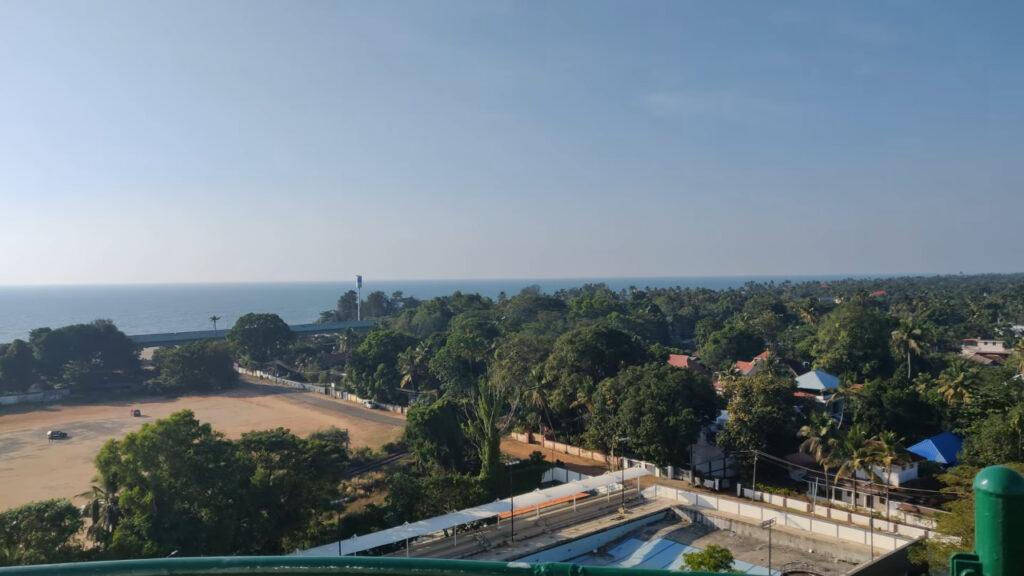- Opened : 28 March 1862
- Open to Public: : 2007
- Height: : 28 m
- Feature: : Red and White horizontal markings with Red lantern
Perched on the sea bridge facing the Arabian Sea coast, just 4 km from the main town, the Alappuzha Lighthouse (also known as the Alleppey Lighthouse) is a marvel of old-world charm. Built in 1862, this historic lighthouse offers breathtaking 360-degree views and houses a museum that preserves fascinating artifacts like old oil lamps, chronicling its 150-year-old journey.





Constructed from laterite stones and teak, the lighthouse stands 30 meters tall and can accommodate up to 25 visitors at a time. The climb up its spiraling staircase, with over 100 wooden steps, is well worth the effort for the magnificent views of Alleppey Beach and the surrounding areas.
Originally, the lighthouse used a double wick, coconut oil lamp until 1952. This was later replaced by a DA gas flasher and a 500 mm drum optic. Over the years, the lighting system evolved, with an emergency lantern of 300mm and a direct drive system, finally being upgraded to a 230V Metal Halide Lamp in 1999.
You May Read
Must Know Before You Visit Alappuzha Lighthouse
Things to Note:
- Visit Early: Arrive early in the day to avoid the crowds and the heat. Will make your visit more enjoyable and comfortable.
- Shoes Off: Must take off your shoes before entering the lighthouse, so be prepared for this requirement.
- Steep Stairway: Stairway inside the lighthouse is quite steep, with over 100 steps. Make sure you’re comfortable with the climb. It’s not advisable for those with foot injuries or a fear of heights.
Alappuzha Lighthouse History
Alappuzha Lighthouse, also known as the Alleppey Lighthouse, is a historical beacon located in the coastal town of Alappuzha, Kerala. Erected in 1862 during the reign of the Travancore king, it stands as a testament to the region’s rich maritime history.
One of the key features of this lighthouse is its significant height, reaching up to 30 meters (about 98 feet), which provides extensive visibility for maritime navigation. Height also makes it a prominent landmark along the Alappuzha coastline, easily visible from both land and sea.
Lighthouse is built using traditional red and white bands, which is a distinctive feature and adds to its aesthetic appeal. These colors not only enhance its visibility during the day but also give it a classic look that is often associated with historical lighthouses.
Museum




Alappuzha Lighthouse houses a small but informative museum that showcases various maritime artifacts, including old lamps, navigational tools, and photographs detailing the history of the lighthouse and the region’s maritime activities. Museum adds educational value to the visit, providing context and background to the lighthouse’s operational history and its importance to local trade and navigation.
Iitems like GAS flashers, sun valves, and radar beacons, offering an insightful journey through the technological advancements in lighthouse operations over the past 150 years.
Alleppey Tip to Fellow Female Travelers:
Spiral stairs to the top of the lighthouse are in the form of planks with gaps in between. Avoid wearing skirts or dresses; instead, opt for jeans or trousers when visiting this lighthouse.
Alleppey Lighthouse Timings
Morning Hours: 9:00 AM – 11:45 AM
Afternoon Hours: 2:00 PM – 5:30 PM
Lighthouse is closed on Mondays. For the best experience, consider visiting early in the morning to avoid the heat and crowds.
Alappuzha Lighthouse Ticket Price
- Indian Adults: INR 10
- Indian Kids: INR 3
- Camera: INR 20
- Video Camera: INR 25
- Foreigners: INR 25
View from the Alleppey Lighthouse

How to Reach Alleppey Lighthouse?
Alleppey Lighthouse, also known as the Alappuzha Lighthouse, is conveniently located near Alleppey Beach, making it easily accessible from various parts of the town.
Entire list of places to visit in Alleppey before you plan your trip.
By Foot: If you’re staying nearby, a leisurely walk to the lighthouse is a great option. It’s just 4 km from the main town, allowing you to enjoy the scenic routes and local sights along the way.
By Auto-Rickshaw: Auto-rickshaws are a popular and affordable mode of transport in Alleppey. Easily hire one from any part of the town, and it will take about 15 minutes to reach the lighthouse.
By Taxi: For a more comfortable and hassle-free journey, you can book a private taxi. Especially convenient if you’re traveling with family or have a lot of luggage.
By Bicycle: If you enjoy cycling, consider renting a bicycle and making your way to the lighthouse. Allows you to explore the area at your own pace and enjoy the fresh coastal breeze.
By Car: If you’re driving, the lighthouse is just off the main car park for Alleppey Beach. There is ample parking space available, making it easy to park your vehicle and walk to the lighthouse.
FAQs
Can visitors climb to the top of the Alleppey Lighthouse?
Yes, visitors can climb to the top of the lighthouse. Climb involves a steep spiral staircase with over 100 steps, leading to a panoramic viewing gallery that offers breathtaking views of the Arabian Sea and the surrounding areas.
What can tourists expect to see at the Alleppey Lighthouse?
Tourists can enjoy stunning 360-degree views from the top of the lighthouse. Inside, there is a small museum that showcases various maritime artifacts, including old lamps, navigational tools, and photographs detailing the history of the lighthouse and the region’s maritime activities.
Is photography allowed at the Alleppey Lighthouse?
Yes, photography is allowed at the lighthouse. There is a small fee for bringing a camera or video camera.
Is there parking available near the Alleppey Lighthouse?
Yes, there is ample parking space available near the lighthouse, making it convenient for visitors arriving by car.
Beauty of Alappuzha, don’t miss out on the historic Alappuzha Lighthouse. Iconic structure, standing tall since 1862, offers a unique glimpse into the region’s maritime heritage. Visitors are drawn to its striking architecture and the panoramic views it provides of the serene backwaters and the Arabian Sea.







